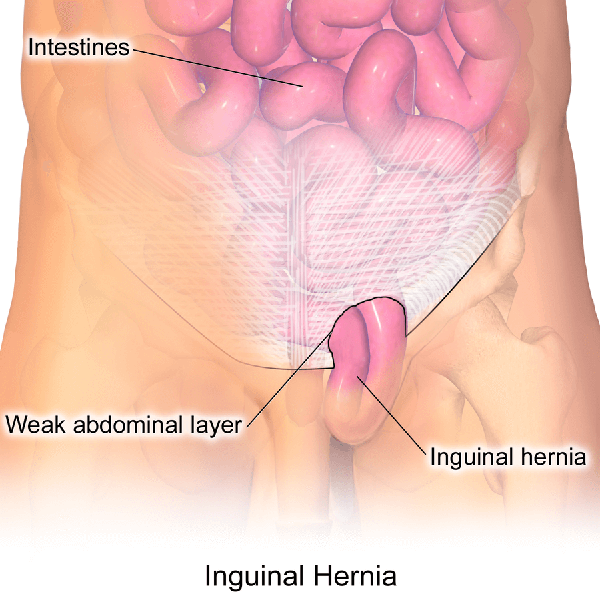A hernia is a weak point in the abdominal wall that results in abnormal protrusion of the abdominal contents (e.g. stomach, intestines) from it. Inguinal hernia occurs when tissue pushes through a weak spot in the groin muscle leading to a bulge in the groin or scrotum.
Symptoms of Inguinal Hernia
Most of the inguinal hernias remain asymptomatic but an increase in the abdominal pressure caused by lifting heavy objects, coughing, straining may call a patients attention to a hernia. In some cases, it may present the following
symptoms:
-
Abnormal bulge in the groin
-
Pain or tenderness over the bulge on coughing, exercising, or bending over
-
Abdominal distention
-
Burning sensations
-
Inability to pass flatus/gas
-
Constipation
-
Diarrhea
-
Fevers with chills
-
Nausea and vomiting

Why is Hernia dangerous?
Hernias are dangerous as they may enlarge over time and may become incarcerated (fail to reduce) or strangulated (loss of hernia contents due to lack of blood supply). That is a medical emergency and may cause death of the patient. To avoid any emergency and complications, a hernia should be surgically repaired.
Diagnosis of Inguinal Hernia
Inguinal hernia can be very well diagnosed on physical examination. It becomes noticeable when the patient does an activity that increases abdominal pressure, such as coughing, sneezing etc. The visibility of a hernia makes it easily diagnosable. But in some cases where only physical examination does not confirm the diagnosis, an ultrasound or CT may confirm the diagnosis.
Laparoscopic Inguinal Hernia Repair:
Laparoscopic repair of the inguinal hernia is performed under general anaesthesia. The surgeon makes about 3-4 small incisions. One of the incisions is used to insert a port (nozzle) that fills the carbon dioxide gas to inflate it. Now laparoscope is inserted through another incision. A laparoscope is a telescope lookalike with a light and camera on the end. It allows the surgeon to clearly view the inside organs on the monitor outside. After careful evaluation, surgeon inserts other surgical instruments through rest of the incisions to repair the hernia. The defect is repaired by placing a soft plastic mesh over the hole (the hernia). The mesh is stapled to the surrounding edge. After completing the repair, the carbon dioxide gas is released out, and incisions are closed with sutures or staples, or covered with glue-like bandage. Patients with hernias in both groins may be repaired through the same incisions.
Advantages of Laparoscopic Inguinal Hernia Repair
-
Faster recovery
-
Only few hours or overnight hospitalization
-
Sooner return to work
-
Very less pain during and after the procedure
-
Smaller incisions without any cut on abdominal muscles
-
Negligible risks and complications
-
Less chances of wound infection
-
High success rate with more than ninety-percent of symptom free patients after ten years of the procedure








